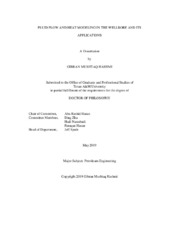| dc.description.abstract | Heat and fluid transport govern many problems in the field of petroleum engineering. Their applications are widespread in almost all aspects of the petroleum production system. This study focuses on one aspect of this system: the wellbore conduit and the fluid and thermal flow inside the wellbore. In this work, multiple fluid and heat flow models are developed to aid in different applications such as transient testing, production rate estimation, and artificial lift. All the models developed are validated using field data or data from literature.
The first category of models is developed for short-term testing. Given that short-duration tests (closed-chamber tests (CCT) and slug) can last only a few minutes, particularly in high-conductivity reservoirs, the challenge was approached with a two-fold strategy. First, a forward model was developed to design the chamber length to ensure that interpretable test data was collected. Second, the CCT and slug tests were combined so that the total test duration could be controlled, particularly in high-conductivity reservoirs. The approach presented here allowed individual treatment of slug, CCT, and reverse-slug or injection test for underpressured reservoirs. Overall, the models present a simple, yet complete approach to design and analysis of these short-term tests.
The next category of models helps to determine production rate by analyzing thermal flow from the wellbore into the formation. The objective of this part of the study is two-fold: to estimate rate from measured temperature data available for downhole telemetry with a rigorous transient analytical model, and to show the possible use of the computed rates to perform pressure transient analysis for both the pre- and post-cleanup periods. Comparing and contrasting permeability estimates from the two periods provides guidance on the suitability of this approach. Another application presented here explores determining zonal contributions similarly using transient analytical model and temperature logging data gathered during a production logging job.
Lastly, a simplified modeling approach is presented for the design of plunger lift for wells in gas reservoirs with significant water production. The proposed model allows for an efficient design of plunger lift by incorporating energy balance in the wellbore. | en |


